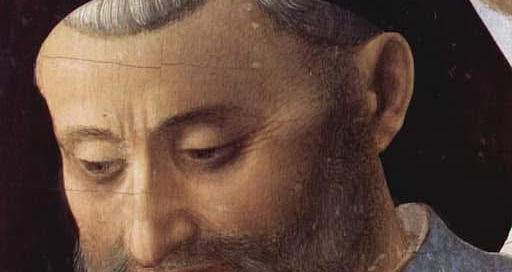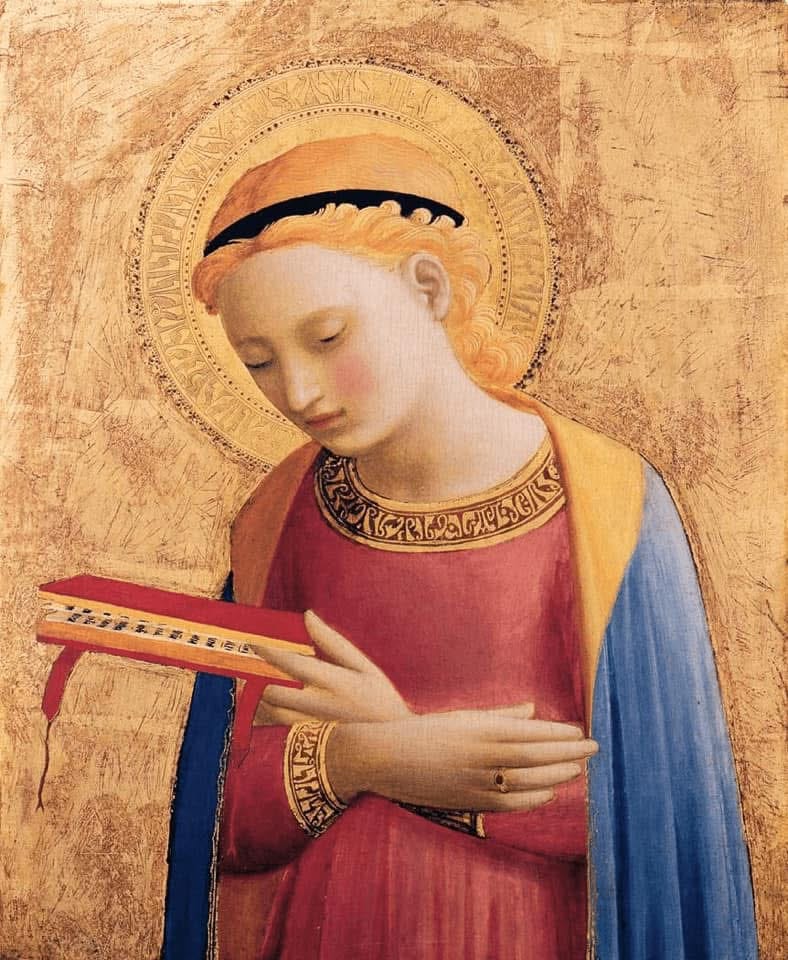Today is the feast of Blessed Fra Angelico. I can safely say that he is my favorite artist simply for the fact that whenever my eye catches a painting of his in a book or on a wall I am immediately brought to equilibrium and peace no matter what is happening otherwise. He speaks the language of Heaven.
Fra Angelico was born Guido de Pietro and grew up in 15th century Italy. He showed artistic talent early on and joined a confraternity, or guild, of painters in his town. He had done at least two frescoes in Churches in his area. His brother Benedetto, with whom he was very close, had gone off to join the Dominican Friary of Fiesole. Guido soon felt a call to join him there in 1423. His name became Fra Giovanni de Fiesole but he must have been serene, humble and quiet man and over time simply became known among his brothers as Fra Giovanni Angelico, the angelic Brother John. Benedetto taught him the fine art of illumination and he worked closely with him for a time. I think this is when Fra Angelico fell in love with and knew how to conjure up the beautiful colors we see in all his frescoes of later years. I find it intriguing because all his paintings have a quality of being ‘illuminated’ to me - just larger ones that seem to have unfolded from an ancient, exquisite Bible.
He was known to never touch up his paintings once he finished, as he firmly believed that each came directly from God’s inspiration and must stay exactly as they had flowed to his brush. With any lesser artist we jaded modernists might say “what vain bosh”, but with Fra Angelico we immediately believe that this humble monk knew he was simply an instrument. The proof is in the paintings.
One of his famous altar pieces: in the Monastery of San Marco, is a Virgin and Child Surrounded by Saints. The unusual thing about the painting is that all the Saints are conversing with each other about the vision of Our Lady and Jesus. Most artists of that time “depicted a setting that was clearly heaven-like, in which saints and angels hovered about as divine presences rather than people. But in this instance, the saints stand squarely within the space, grouped in a natural way as if they were able to converse about the shared experience.” I find that charming; saints standing squarely in Heaven with all their old temperaments unmarred, sharing the experience of joy with each other - and not alone in silence. Oh to be privy to the conversations! Our Lady must have been quite entertained.
I am also charmed by the fact that many of his paintings were made for his fellow monks in the friary of San Marco where he spent much of his life. His work can be found in the corridors, on the walls in the refectory, in the chapter room and most charming of all, on each of his brother monks’ walls as cell pictures of their favorite patron saints. He delighted most in painting Our Lady and Angels. All this glorious art gracing the walls of a simple Dominican friary because his superiors asked. My favorite of all his paintings is the Annunciation.
Sister Wendy Beckett, a lovely, lovely and quite spiritually astute art historian, points out that this particular Annunciation is right at the top of the stairs leading to the dormitories of the monks. She posits that perhaps the friars trudging up the stairs at the end of a day could look up and remember their own ‘fiat’ given at profession. This might have given them a second wind and they went to bed in peace ready for another day tomorrow. Our Lady was rooting for them. I think she is absolutely correct!
C.S. Lewis, when speaking of angels once, said this. I agree most heartily with his assessment. He truly understood Fra Angelico’s art.
“A belief in angels, whether good or evil, does not mean a belief in either as they are represented in art and literature. . . . They are given wings . . . in order to suggest the swiftness of unimpeded intellectual energy. They are given human form because man is the only rational creature we know. Creatures higher in the natural order than ourselves, either incorporeal or animating bodies of a sort we cannot experience, must be represented symbolically if they are to be represented at all. . .In the plastic arts these symbols have steadily degenerated. Fra Angelico’s angels carry in their face and gesture the peace and authority of heaven. Later come the chubby infantile nudes of Raphael; finally the soft, slim, girlish and consolatory angels of nineteenth-century art. . . They are a pernicious symbol. In Scripture the visitation of an angel is always alarming; it has to begin by saying “Fear not.” The Victorian angel looks as if it were going to say “There, there.”
I have always seen Fra Angelico’s angels in just this way. Beautiful but never lacking in authority. They have a message from the Most High and they deliver it in all dignity and grandeur.
I was very excited when he was beatified in 1982 by his fellow saint John Paul II, who then pronounced him the Patron Saint of Catholic Artists.
Blessed Fra Angelico, pray for all Catholic artists! Thank you for your prayerful paintings!
I do not feel inclined at this time to have a paid substack. But if we were together in a cafe discussing all these thoughts, I would not be opposed to you buying me a cup of coffee - with cream, of course. In that spirit, if any of my posts resonate with you and you feel so inclined, you can donate here: buymeacoffee.com/denise_trull











I didn't know he'd studied illumination, but I agree with your judgement that "all his paintings have a quality of being ‘illuminated’".
I was lucky enough to be able to visit San Marco to see all of his paintings in the place where they were made. One of the things I find most charming about his annunciation is that the architecture of the space where Mary makes it clear that she's in San Marco itself, the vaulted ceilings are the same. Like he's saying: this is here and now.
I fell in love with his work upon seeing his frescos at Vatican. They are magical. What beautiful work!